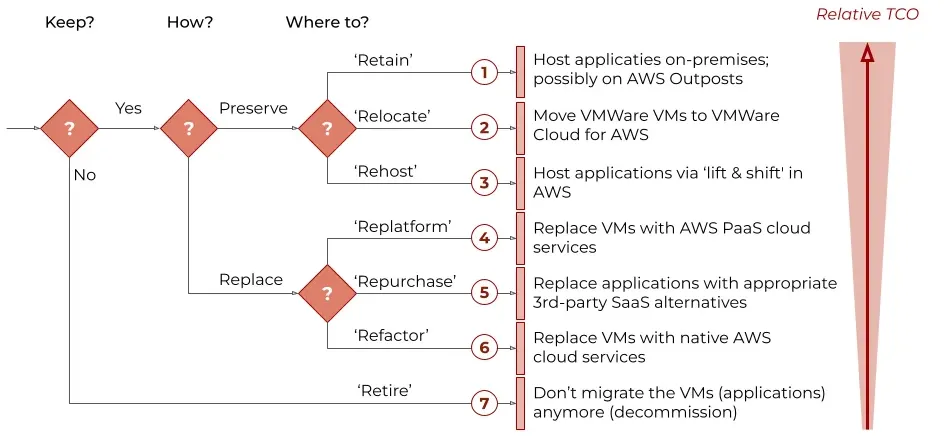Understanding the “7 Rs” - Cloud Migration Strategies
Cloud Migration Strategies
- Migration Strategy
- Cloud Migration
- Cloud Transformation
- The Origin of R Models
- The “7 Rs” in Detail
- When to Use Each Migration Model
- Real-Life Examples Using R Models
- Final Thoughts
- Assessment and planning: This involves evaluating the existing system, identifying the components to be migrated, assessing dependencies, and determining the best approach for migration.
- Risk assessment: Identifying potential risks and challenges associated with the migration and developing mitigation strategies.
- Data migration: Planning for the transfer of data from the existing system to the new system, ensuring data integrity, and minimizing downtime.
- Application migration: Addressing the migration of applications, including re-platforming, re-hosting, or re-architecting as necessary.
- Testing: Developing a comprehensive testing plan to validate the migrated system’s functionality, performance, and security.
- Training and change management: Planning for the training of staff and stakeholders on the new system, as well as managing the organizational change associated with the migration.
- Rollback plan: Developing a contingency plan to revert to the original system in case of migration failure.



Pros:
- Requires the least investment in cost, time, and effort
- Eliminates IT spend on idle resources
Cons:
Premature or unplanned retiring of workloads may result in incompatibility with interconnected stacks
Pros:
- Saves cloud resources by retaining inefficiencies on-premises.
- Allows for evaluation of (recently upgraded) applications in order to identify those that require immediate migration or those that could be migrated at a later date.
Cons:
- Lack of cloud-native capabilities.
- Requires costly and continuous maintenance.
Pros:
- Requires minimal risk and disruption.
- Minimizes issues concerning compatibility, disruption, long migrations, or long-distance data replications.
- Increase reliability, resilience and scale applications without costly upgrades.
- Easier to integrate and to optimize or re-factor applications once they have been rehosted to the cloud.
- Enables complete transfer of legacy workloads.
Cons:
- Introduces operational and technical incompatibilities, affecting user experience.
- Limited number of cloud-native capabilities.
Pros:
- Quickest migration strategy.
- Requires minimal staff training.
- Reduces data center operational costs.
- Requires no change in operational processes for migrated workloads.
Cons:
- PaaS services can be expensive.
- Scaling down instances to save on costs becomes a very challenging task.
Pros:
- Quick adoption of cloud-native capabilities.
- Reduces existing applications’ licensing, infrastructure, and maintenance issues and costs.
Cons:
- Updates and releases are performed at the vendor’s cadence.
- Costs can accumulate quickly for repurchasing multiple applications.
- The need to train users and teams on new systems.
- New products might not fully resemble current processes.
- Vendor lock-in.
Pros:
- Offers the ability to choose specific features for maximum ROI.
- No extensive training required.
- Enables IT teams to proactively monitor the effectiveness of cloud-native capabilities before migrating additional workloads.
Cons:
- Changes are costly and can be very time-consuming.
- May lead to reduced application availability during the migration phase.
Pros:
- Enables organizations to achieve end-to-end cloud-native capabilities of the well-architected framework.
- Ensures business continuity.
- Offers personalized levels of automation, scaling, and high availability.
Cons:
- Relies on extensive staff training and cloud expertise.
- Requires thorough planning, budgeting, and execution.
- More complex to manage, requiring continuous monitoring for cost optimization.
- Netflix (Streaming): They embraced the rehost (lift-and-shift) approach to migrate its massive infrastructure from on-premises data centers to Amazon Web Services (AWS) which allowed them to scale quickly, improve reliability, and reduce costs.
- Capital One (Banking): They opted for the repurchase model, replacing its legacy systems with AWS marketplace solutions, leading to improved agility and faster time-to-market for new products and services.
- Airbnb (Rental Platform): They utilized the rebuild (re-develop) approach to modernize its infrastructure and embrace a microservices architecture, allowing them to improve scalability, enhance performance, and introduce new features quickly.
- Expedia (Travel): They adopted a hybrid approach, leveraging the refactor (re-architect) and repurchase strategies, allowing them to optimize its applications for AWS while also taking advantage of pre-built solutions.
- https://www.gartner.com/en/documents/1485116
- https://aws.amazon.com/blogs/enterprise-strategy/6-strategies-for-migrating-applications-to-the-cloud/
- https://docs.aws.amazon.com/prescriptive-guidance/latest/application-portfolio-assessment-guide/iterating-7-rs-migration-strategy-selection.html
- https://docs.aws.amazon.com/prescriptive-guidance/latest/application-portfolio-assessment-guide/prioritization-and-migration-strategy.html
- https://docs.aws.amazon.com/prescriptive-guidance/latest/large-migration-guide/migration-strategies.html
